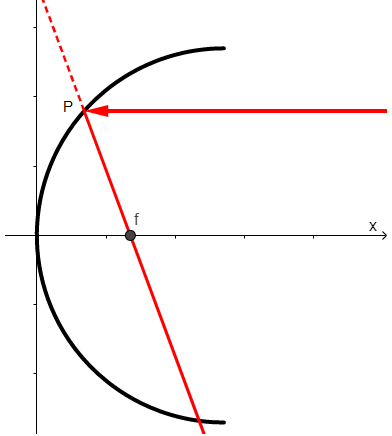
A ray of light is coming along the line $y=b$ from the positive direction of x-axis and strikes a concave mirror whose intersection with the \[xy\] -plane is a parabola ${{y}^{2}}=4ax$. Find the equation of the reflected ray and show that it passes through the focus of the parabola. Both a and b are positive.
Answer
219.3k+ views
Hint: As the reflected ray passes through the focus and we know the coordinates of the focus. So first we will find the intersection of a ray of light and a concave mirror and then use the equation of line formula to find the required equation.
Complete step-by-step answer:
In a concave mirror if the ray of light is parallel to the axis of the mirror, then the reflected ray will pass through the focus of the concave mirror.
As per the information given, we can draw the diagram as follows.

Let the ray of light meet the concave mirror at point P. Then Pf is the reflected ray where f is the focus of the concave mirror.
The equation of parabola or the equation of the concave mirror is,
${{y}^{2}}=4ax$
So, the coordinate of the point f will be $\left( a,0 \right)$.
As it is given that ray of light with equation $y=b$ strikes the concave mirror, so substituting the value of ‘y’ we get,
${{b}^{2}}=4ax$
$x=\dfrac{{{b}^{2}}}{4a}$
So, the coordinates of the point P is $\left( \dfrac{{{b}^{2}}}{4a},b \right)$ .
Now the slope of the line passing through two points $\left( {{x}_{1}},{{y}_{1}} \right)$ and $\left( {{x}_{2}},{{y}_{2}} \right)$is given by,
$m=\dfrac{\left( {{y}_{2}}-{{y}_{1}} \right)}{\left( {{x}_{2}}-{{x}_{1}} \right)}$
So, the slope of the line passing through point \[f\left( a,0 \right)\] and \[P\left( \dfrac{{{b}^{2}}}{4a},b \right)\] is,
$m=\dfrac{b-0}{\dfrac{{{b}^{2}}}{4a}-a}$
$\Rightarrow m=\dfrac{b}{\dfrac{{{b}^{2}}-4{{a}^{2}}}{4a}}$
$\Rightarrow m=\dfrac{4ab}{{{b}^{2}}-4{{a}^{2}}}$
Now we know the line of equation passing through the point $\left( {{x}_{1}},{{y}_{1}} \right)$is,
$y-{{y}_{1}}=m\left( x-{{x}_{1}} \right)$
where ‘m’ is the slope of the line.
So, the equation of line passing through the point \[f\left( a,0 \right)\]with slope, $m=\dfrac{4ab}{{{b}^{2}}-4{{a}^{2}}}$, is,
$y-0=\left( \dfrac{4ab}{{{b}^{2}}-4{{a}^{2}}} \right)\left( x-a \right)$
$\Rightarrow \left( {{b}^{2}}-4{{a}^{2}} \right)y=4ab\left( x-a \right)$
$\Rightarrow 4abx-4{{a}^{2}}b-\left( {{b}^{2}}-4{{a}^{2}} \right)y=0$
$\Rightarrow 4abx-\left( {{b}^{2}}-4{{a}^{2}} \right)y-4{{a}^{2}}b=0$
Now as the reflected ray is passing through the focus, i.e., f, so the equation of reflected ray is,
$4abx-\left( {{b}^{2}}-4{{a}^{2}} \right)y-4{{a}^{2}}b=0$
Note: In this instead using the slope form of the equation of line we can use the point form of equation of line formula as well. In both cases you will get the same answer.
Complete step-by-step answer:
In a concave mirror if the ray of light is parallel to the axis of the mirror, then the reflected ray will pass through the focus of the concave mirror.
As per the information given, we can draw the diagram as follows.

Let the ray of light meet the concave mirror at point P. Then Pf is the reflected ray where f is the focus of the concave mirror.
The equation of parabola or the equation of the concave mirror is,
${{y}^{2}}=4ax$
So, the coordinate of the point f will be $\left( a,0 \right)$.
As it is given that ray of light with equation $y=b$ strikes the concave mirror, so substituting the value of ‘y’ we get,
${{b}^{2}}=4ax$
$x=\dfrac{{{b}^{2}}}{4a}$
So, the coordinates of the point P is $\left( \dfrac{{{b}^{2}}}{4a},b \right)$ .
Now the slope of the line passing through two points $\left( {{x}_{1}},{{y}_{1}} \right)$ and $\left( {{x}_{2}},{{y}_{2}} \right)$is given by,
$m=\dfrac{\left( {{y}_{2}}-{{y}_{1}} \right)}{\left( {{x}_{2}}-{{x}_{1}} \right)}$
So, the slope of the line passing through point \[f\left( a,0 \right)\] and \[P\left( \dfrac{{{b}^{2}}}{4a},b \right)\] is,
$m=\dfrac{b-0}{\dfrac{{{b}^{2}}}{4a}-a}$
$\Rightarrow m=\dfrac{b}{\dfrac{{{b}^{2}}-4{{a}^{2}}}{4a}}$
$\Rightarrow m=\dfrac{4ab}{{{b}^{2}}-4{{a}^{2}}}$
Now we know the line of equation passing through the point $\left( {{x}_{1}},{{y}_{1}} \right)$is,
$y-{{y}_{1}}=m\left( x-{{x}_{1}} \right)$
where ‘m’ is the slope of the line.
So, the equation of line passing through the point \[f\left( a,0 \right)\]with slope, $m=\dfrac{4ab}{{{b}^{2}}-4{{a}^{2}}}$, is,
$y-0=\left( \dfrac{4ab}{{{b}^{2}}-4{{a}^{2}}} \right)\left( x-a \right)$
$\Rightarrow \left( {{b}^{2}}-4{{a}^{2}} \right)y=4ab\left( x-a \right)$
$\Rightarrow 4abx-4{{a}^{2}}b-\left( {{b}^{2}}-4{{a}^{2}} \right)y=0$
$\Rightarrow 4abx-\left( {{b}^{2}}-4{{a}^{2}} \right)y-4{{a}^{2}}b=0$
Now as the reflected ray is passing through the focus, i.e., f, so the equation of reflected ray is,
$4abx-\left( {{b}^{2}}-4{{a}^{2}} \right)y-4{{a}^{2}}b=0$
Note: In this instead using the slope form of the equation of line we can use the point form of equation of line formula as well. In both cases you will get the same answer.
Recently Updated Pages
The maximum number of equivalence relations on the-class-11-maths-JEE_Main

A train is going from London to Cambridge stops at class 11 maths JEE_Main

Find the reminder when 798 is divided by 5 class 11 maths JEE_Main

An aeroplane left 50 minutes later than its schedu-class-11-maths-JEE_Main

A man on the top of a vertical observation tower o-class-11-maths-JEE_Main

In an election there are 8 candidates out of which class 11 maths JEE_Main

Trending doubts
JEE Main 2026: Application Form Open, Exam Dates, Syllabus, Eligibility & Question Papers

Derivation of Equation of Trajectory Explained for Students

Hybridisation in Chemistry – Concept, Types & Applications

Understanding the Angle of Deviation in a Prism

Understanding Collisions: Types and Examples for Students

Understanding Atomic Structure for Beginners

Other Pages
JEE Advanced Marks vs Ranks 2025: Understanding Category-wise Qualifying Marks and Previous Year Cut-offs

NCERT Solutions for Class 11 Maths Chapter 10 Conic Sections

NCERT Solutions for Class 11 Maths Chapter 9 Straight Lines

NCERT Solutions For Class 11 Maths Chapter 8 Sequences And Series

How to Convert a Galvanometer into an Ammeter or Voltmeter

NCERT Solutions For Class 11 Maths Chapter 12 Limits And Derivatives




